Your first telescope or binocular has just arrived and now you can’t wait to try it out. Trust me, I remember this feeling very well. The universe is calling and it want to be discovered by you. There are so many exciting objects to explore. So, what to aim your telescope at? I created a list of ten celestial objects that are great for beginners with binoculars or small telescopes. The targets described represent different kinds of objects that exist in the universe. All objects are easy to find, and their size makes them equally suited for refractors, reflectors, catadioptric telescopes or binoculars. With the exception of the last listing, the Dumbbell Nebula (M27), all objects can be observed even with full moon.
Top 10 Objects for Binoculars and Small Telescopes
- Moon
- Jupiter – Planet
- Saturn – Planet
- Mizar & Alcor – Multiple Star System
- Albireo – Beautiful Double Star
- Orion Nebula, M42 – Nebula
- Andromeda Galaxy, M31 – Spiral Galaxy
- Hercules Cluster, M13 – Globular Cluster
- Double Cluster, NGC 869 & NGC 884 – Close Open Clusters
- Dumbbell Nebula, M 27 – Planetary Nebula

_________________________________________________________________
Moon
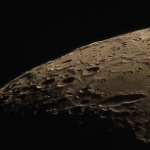
| Facts: | |
| The Moon came into existence when a Mars-size planet crashed into the early Earth. Fragments orbited the Earth and coalesced within just several weeks to become the Moon. The dark areas visible today at the moon are called Maria, from Latin “Sea”. They are meteorite craters that flooded with hot lava. Lava layers can be up to 10 km (6.2 miles) thick, higher than Mount Everest. | Diameter: 3 476 km (27% of Earth) Distance to Earth: 384 000 km (199,000 miles) Mass: 7.350 x 10E19 tons (1.2% of Earth) Density: 3.341 g/cm3 (61% of Earth) |
_________________________________________________________________
Jupiter

Jupiter is the largest planet in our solar system. It is a very bright and exciting object to observe. Four moons can be seen even with small telescopes or binoculars. If the conditions are good some cloud bands are also visible, and with larger telescopes it might be possible to see some cloud details and the great red spot.
TIP: It is fun to draw the position of the moons and follow them over a period of time.
Click here for more information about the position of planets.
| Facts: | |
| Jupiter is a gas giant with over 100 moons. The four largest are Io, Europe, Ganymede, Callisto. They are also called the Galilean moons. When Galileo saw the movement of the moons he could no longer accept a geocentric model of the universe. | Diameter: 142 980 km (11.2 x Earth) Mass: 1.899 x 10E24 tons (318 x Earth) Density: 1.32 g/cm3 (24% of Earth) Distance from Sun: 4.95 AU |
_________________________________________________________________
Saturn
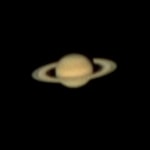
With a very small telescope or under not so good seeing conditions, Saturn’s rings might just be seen as “ears”. In fact, this is what Galileo saw when he first looked at Saturn with his telescope. He concluded that these “ears” must be two close moons on either side of Saturn, but two years later the “moons” were gone, and again two years later the “moons” re-appeared. We know today, that the “disappearance” was caused by looking at the ring edge on but it was very confusing for Galileo at that time.
Click here for more information about the position of planets.
| Facts: | |
| Saturn is a gas giant, and has over 62 moons, with Titan and Rhea as the largest ones. Saturn has a very low density. In fact, if we could build a bathtub large enough to hold Saturn, it would float on the surface. | Diameter: 123 000 km (9.4 x Earth) Mass: 0.569 x 10E24 tons (95 x Earth) Density: 0.67 g/cm3 (24% of Earth) Distance from Sun: 9.54 AU |
_________________________________________________________________
Mizar & Alcor
The Big Dipper is probably the best known asterism for stargazers in the Northern hemisphere. Big Dipper consists of seven stars and belongs to the constellation Ursa Major, or Great Bear. It is easy to find and its serves as guidepost to Polaris. Find the brightest two stars at the outer bowl edge, Dubhe and Merak. Take 5 times their distance and you reach Polaris, the Northern Star.
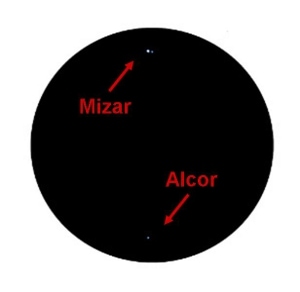
Big Dipper holds some surprises that are revealed at closer observation. Point your telescope at the handle bend and what you see are not one but two stars. The brighter one is Mizar, the dimmer star is Alcor. They are also known as “Horse and Rider”. People with good eyesight can distinguish these two stars with bare eyes. If the seeing conditions are good, choose high magnification and take a closer look at Mizar. You will see that Mizar itself has another close companion star. The image above shows an actual photo of Mizar A, his close companion Mizar B and Alcor (click at the image to open a larger scale version).
Click here for a star map of Ursa Major.
| Facts: | |
| The Mizar – Alcor system consists of even more stars that are however too faint for small telescopes. Four stars belong to the local Mizar system and the Alcor system consists of two. New research has revealed that both systems are gravitationally linked, making Mizar & Alcor a true 6-star system. | Constellation: Ursa Major, UMa Magnitude (Mizar/Alcor): 2.2 /4.0 Separation: 11.8′ Distance: 83 light years Mass (Mizar/Alcor): 7.7 /2 x Sun, Diameter: 4.1 / 1.8 x Sun Luminosity: (Mizar/Alcor): 63 / 13 x Sun |
Back to table
_________________________________________________________________
Albireo
In the night sky: late Spring to Fall.
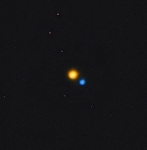
Image credit: Hunter Wilson.
When observing colorful stars, it can be beneficial to do this somewhat out of focus. Since the star disks become larger, colors become more prominent. The reason for this is that a larger number of color receptors in the eyes can collect color information . Play with your focuser and see what works best for you.
Click here for a star map of Cygnus.
| Facts: | |
| At this point it is unknown whether the stars are optical doubles or gravitational linked and orbiting each other.The brighter star itself has a very close companion, too close though to be resolved with a telescope. | Constellation: Cygnus, CYG Magnitude: A 3.2, B 5.8 Separation 35″ Distance 390 / 390 light years Mass: 5 / 3.2 x Sun Diameter: 16 / 2.7 x Sun Luminosity: 950 / 120 x Sun |
_________________________________________________________________
Orion Nebula (M42)
In the night sky: Winter and Spring.
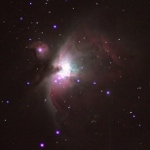
Because M42 is over an arc minute wide use your lowest magnification to ensure it fits in the field of view. The four stars at its center are called “Trapezium”, they energize and ionize surrounding gasses which leads to this beautiful spectacle. Due to its brightness, the Trapezium stars draw the observers attention, but when scanning the area around them, you will see many smaller stars and layers of ionized gas.
Click here for a star map of Orion.
| Facts: | |
| Orion nebula is the closest region of massive star formation to the Earth. It hosts protoplanetary discs and brown dwarfs. New stars and planets are born there right now. The strong radiation emitted by the Trapezium stars is so powerful that young neighbor stars are pushed into the form of an egg. | Constellation: Orion, ORI Magnitude: 4.0 Size: 65’x60′ Distance 1,344 light Years Diameter: 24 light Years Mass: 2,000 x Sun |
_________________________________________________________________
Andromeda Galaxy (M31)
In the night sky: Summer, Fall and Winter.

There are many ways finding the Andromeda Galaxy in the night sky. My favorite is to extend the most pointy part of the Cassiopeia “W” three times.
Click here for star maps of Andromeda and Cassiopeia.
| Facts: | |
| The Andromeda Galaxy is a spiral galaxy has an estimated 1 Trillion stars (Milky Way 200 – 400 Billion). Its center comprises a massive black hole. Andromeda Galaxy and the Milky Way are moving towards each other. They will merge in about 4.5 Billion years. | Constellation: Andromeda, AND Magnitude: 3.44 Distance 2.54 Million light years Mass: 1- 1.5 x Milky Way galaxy |
_________________________________________________________________
Hercules Cluster (M13)
In the night sky: Spring, Summer and Fall.
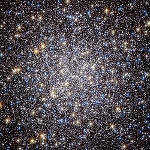
Image Credit: ESA, NASA
It is a bit more challenging to find Hercules Globular Cluster. First we have to find “The Keystone”, four stars of the constellation Hercules that build a trapezoid. M13 lies on the line between Eta Herculis and Zeta Herculis. These are the two stars in “The Keystone” at the side of Arcturus. Move a little bit towards Eta on the Eta-Zeta line and you have found this beautiful globular cluster. If you have difficulties to find “The Keystone”, two bright stars, Vega and Arcturus help. Draw a line from Vega to Arcturus, “The Keystone” is located about one third the distance from Vega.
Click here for a star map of Hercules.
| Facts | |
| Despite it’s age, Hercules Globular Cluster has not changed its form much. Pressure of star radiation pushing stars apart and gravity force pulling them together, resulting in an equilibrium. The stable conditions were thought to be beneficial for possible forming of life. In 1974 a radio message was sent to the Hercules Cluster with the large Arecibo radio telescope. The digital message included information about man, earth and the solar system. | Constellation: Hercules, HER Magnitude: 5.8 Distance 25,100 light years Diameter: 168 light years Mass: 600,000 times Sun Age: 14 Billion years |
_________________________________________________________________
Double Cluster (NGC 869 & NGC884)
In the night sky: Fall, Winter, Early Spring.

The Double Cluster belongs to the constellation Perseus. It can be easily found with the help of the constellation Cassiopeia. Just follow the inner leg of the shallow half of the “W” (Cassiopeia Gamma – Delta) about two third of the way to the next bright star, and you will find the Double Cluster.
Click here for star maps of Perseus and Cassiopeia.
| Facts: | |
| The Greeks knew about the object as early as 130 BC, but the true nature of it was not discovered not before the telescope was invented. The radiant of the Perseid meteor shower (Aug 12 & 13) is located in the neighborhood of the Double Cluster (SW). |
Constellation: Perseus, PER Magnitude: 4.2 Distance (NGC 869): 6,800 light years Distance (NGC 884): 7,600 light years Age (NGC 869): 5.6 Million years Age (NGC 884): 3.2 Million years |
_________________________________________________________________
Dumbbell Nebula (M27)
In the night sky: Fall, Winter, Spring

Click here for star maps of Vulpecula, Cygnus and Sagitta.
| Facts: | |
| M27 is a planetary nebula. This term was coined by early astronomers who thought these nebulae were planets. In fact, they have nothing to do with planets. Planetary nebulae are clouds of material, shed by a star. It glows because it is excited by radiation emitted by a nearby object. | Constellation: Vulpecula, VUL Magnitude: 7.5 Distance 1,360 light years Diameter: 1.44 light years Central star Dia: 0.055 Sun, Mass: 0.56 Sun Age: only 9800 years |
